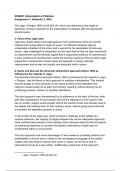IOS2601 Interpretation of Statutes
Assignment 1, Semester 2, 2023
The Jaga v Dönges 1950 (4) SA 653 (A), which was delivered at the height of
apartheid, remains important for the interpretation of statutes after the democratic
transformation;
a. Facts of the Jaga case:
Jaga was caught selling unwrought gold and was sentenced to three (3) months
imprisonment suspended for three (3) years. The Minister declared Jaga an
undesirable inhabitant of the Union and a warrant for his deportation to India was
issued. Jaga challenged his deportation on the basis that he had not been sentenced
to imprisonment and the Minister argued that a suspended sentence of imprisonment
is still a sentence of ‘imprisonment’ within the ordinary meaning of the provision Jaga
argued that ‘imprisonment’ meant actual (as opposed to merely potential)
imprisonment and he was not actually and physically held in prison.
b. Name and Discuss the dominant interpretive approach before 1994 as
followed by the majority in Jaga;
The dominant interpretive approach before 1994, as followed by the majority in Jaga
v Dönges,1 was the literal or strict approach to statutory interpretation. This method
requires judges to focus primarily on the actual wording of the legislation and
interpret it based solely on its plain and ordinary meaning, without delving into its
underlying purpose, context, or societal implications.
The strict approach was characterised by its adherence to the letter of the law, often
with little consideration for the broader intent of the legislature or the impact of the
law on society. Judges would typically look at the specific words and phrases used in
the statute and interpret them in their ordinary sense, without going beyond the text
to ascertain the legislative purpose or policy.
In the context of the Jaga case, which involved a challenge to the validity of a
medical ordinance, the majority of judges followed this narrow interpretive approach.
They confined their analysis to the wording of the ordinance itself and did not explore
its underlying objectives or consider the broader implications it might have on
fundamental rights or social justice.
The strict approach had some advantages. It was viewed as providing certainty and
predictability in the law since it relied on the unambiguous language of the statute.
Judges were less likely to impose their views or values, as the focus was on
interpreting the law as it was written. Additionally, proponents of this approach
1
Jaga v Dönges (1950) SA 653 (A).
, argued that if the legislature intended to achieve a different outcome, they could
amend the legislation accordingly.
However, the strict approach also had significant limitations. Concentrating solely on
the text, it could lead to unjust or inequitable results, particularly when interpreting
laws that were drafted without taking into account the complexities of real-life
situations or evolving societal norms. Critics argued that this approach did not
consider the broader context or the Constitution's principles, leading to potential
contradictions with the constitutional ethos.
As a result, the strict approach to statutory interpretation was criticised for its inability
to adapt to changing social and political realities. This limitation became increasingly
apparent as South Africa underwent significant political and legal transformations
during the post-apartheid era, leading to the need for a more flexible and purposive
interpretive approach, which was eventually codified in Section 39(2) of the
Constitution.2
c. NAME and DISCUSS the alternative interpretive approach as followed by the
minority in Jaga;
The alternative interpretive approach, as followed by the minority in Jaga v Dönges,3
was the purposive or contextual approach to statutory interpretation. Unlike the strict
approach favoured by the majority, this method focused on understanding the
legislative purpose and intent behind the statute, rather than just the literal meaning
of its words.
The minority judges in the Jaga case believed that statutory interpretation should not
be confined to a mechanical and literal reading of the text. Instead, they argued that
judges should look beyond the specific words and phrases used in the law and
consider the broader objectives and spirit of the legislation. This approach aimed to
determine what the legislature intended to achieve with the law, taking into account
the social, political, and historical context in which it was enacted.
The minority judges believed that laws should be interpreted in a manner that
promotes justice, fairness, and the advancement of societal values. They recognized
that legislation was not created in a vacuum but was a response to societal needs
and aspirations. Therefore, to give effect to the purpose of the law, judges should
take into consideration the social and economic consequences of their
interpretations.
In the context of the Jaga case, the minority judges looked beyond the narrow
wording of the medical ordinance and explored the broader intention behind the
2
The Constitution of the Republic of South Africa, 1996.
3
Jaga v Dönges (1950) SA 653 (A).





